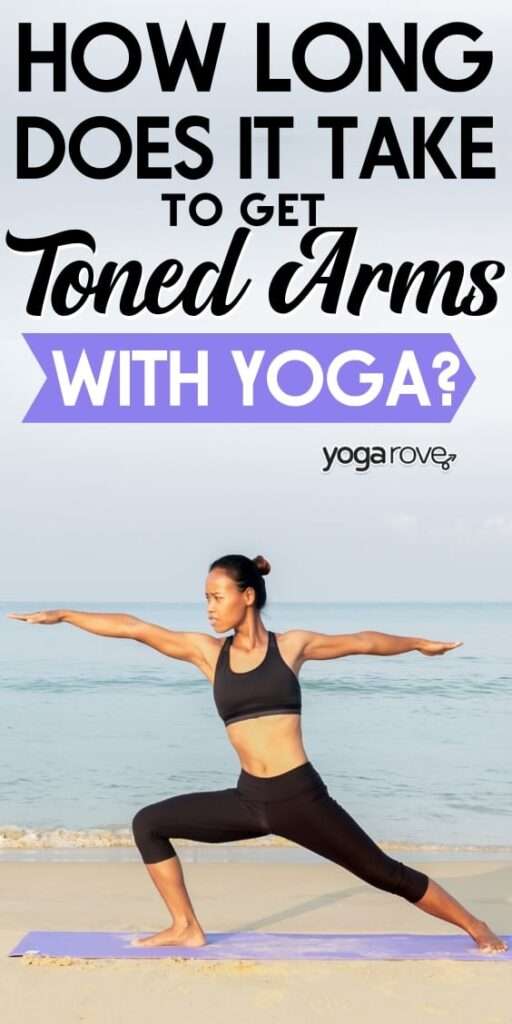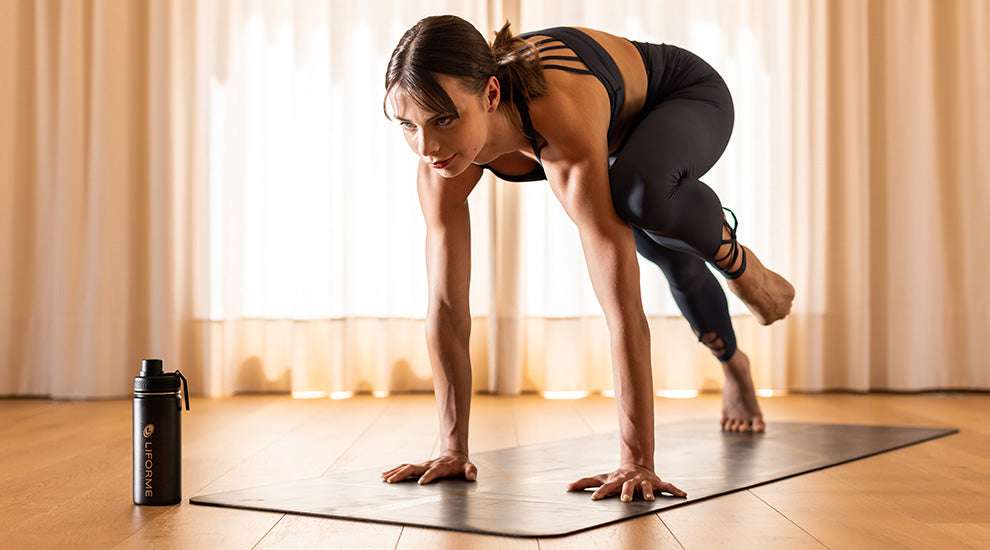If you’ve been looking for a new exercise routine to help tone your body, then you might want to consider regular yoga practice. Many people think of yoga as just a way to relax and increase flexibility, but it can actually be a great workout for sculpting and toning muscles. In this article, we will explore the various ways that regular yoga practice can help in toning your body, from strengthening and lengthening muscles to improving overall body composition. So if you’re ready to take your fitness journey to the next level, grab your yoga mat and let’s get started!
The Benefits of Yoga for Toning Your Body
Yoga, often known for its ability to calm the mind and improve flexibility, can also be an excellent practice for toning your body. While it may not be as intense as traditional strength training exercises, yoga offers unique benefits that can help you achieve a more toned physique. Let’s explore some of the key advantages of incorporating yoga into your fitness routine.
Improved Muscle Strength
One of the main benefits of practicing yoga is the improvement in muscle strength. While some yoga poses may not seem as challenging as lifting weights or doing push-ups, they require you to engage various muscle groups to maintain proper form and balance. Poses such as the Warrior II pose and the Plank pose, which we will discuss in more detail later, can help strengthen your core, arms, legs, and back, leading to improved muscle definition and overall strength.
Increased Flexibility
Flexibility is another significant aspect of toning your body, and yoga is renowned for its ability to enhance flexibility. As you move through various poses, you will gradually increase your range of motion and stretch your muscles. The slow and controlled movements in yoga help lengthen and stretch the muscles, preventing tightness and improving overall flexibility. Increased flexibility can greatly contribute to toned muscles, as it allows for a fuller range of motion during exercises and helps prevent injuries.
Enhanced Definition
Yoga can bring about a noticeable enhancement in muscle definition. While traditional strength training exercises primarily focus on building muscle mass, yoga poses work by elongating and toning the muscles. As you engage in various yoga poses, you activate and target specific muscle groups, working them in a different way than traditional strength training. This unique approach to muscle activation can result in a more sculpted and defined physique.
Weight Loss
In addition to toning your body, yoga can also aid in weight loss. While yoga may not burn as many calories as high-intensity cardio exercises like running or cycling, it can still contribute to weight loss when combined with a balanced diet and regular cardiovascular exercise. The physical demands of yoga, coupled with the meditative and mindful aspects of the practice, can help increase your awareness of hunger cues and promote healthier eating habits, leading to weight loss over time.
Improved Posture
Proper posture not only makes you look taller and more confident, but it also plays a crucial role in toning your body. Yoga helps improve posture by strengthening the muscles that support your spine, such as the core, back, and neck muscles. By practicing yoga regularly, you will gradually develop better alignment and balance, reducing the risk of slouching or developing postural imbalances. Improved posture not only enhances your overall appearance but also helps tone and tighten your abdominal area and back muscles.
Balanced Body Composition
Achieving a balanced body composition involves reducing body fat and increasing muscle mass. Yoga can contribute to this goal by helping you build lean muscle and decrease excess body fat. By incorporating strength-building yoga poses into your routine, you can increase your muscle mass, which in turn boosts your metabolism and helps burn calories more efficiently. Furthermore, yoga’s focus on mindfulness and self-awareness can lead to healthier lifestyle choices, such as a well-balanced diet and portion control, which are crucial for achieving and maintaining a balanced body composition.
Specific Poses for Toning Your Body
Now that we understand the broad benefits of yoga for toning, let’s explore some specific poses that can target and tone different muscle groups in your body.
Warrior II Pose
The Warrior II pose is an excellent pose for toning the lower body, particularly the quadriceps, hamstrings, and glutes. To perform this pose, start in a standing position with your feet positioned wide apart. Turn your right foot out 90 degrees and extend your arms parallel to the ground, with your palms facing down. Bend your right knee, ensuring it aligns with your ankle, and gaze over your right fingertips. Hold this pose for several breaths before repeating on the other side. The Warrior II pose not only strengthens and tones the lower body but also helps improve balance and focus.
Plank Pose
The plank pose is a fantastic pose for toning the core, arms, and shoulders. Begin by positioning yourself in a push-up position, with your palms flat on the ground, directly beneath your shoulders. Keep your legs extended and engage your core muscles to maintain a straight line from your head to your heels. Hold this pose for as long as you can while maintaining proper form. The plank pose helps strengthen the entire core, including the abs, obliques, and lower back, resulting in a more toned and defined midsection.
Boat Pose
The boat pose, also known as Navasana, is an effective pose for toning the abdominal muscles and hip flexors. Start by sitting on the floor with your legs extended in front of you. Bring your hands slightly behind you for support. Lean back slightly and lift your legs off the ground, keeping them straight. Engage your core muscles and balance on your sitting bones while extending your arms forward, parallel to the floor. Hold this pose for several breaths before releasing. The boat pose not only tones the abs but also improves balance and strengthens the lower back.
Bridge Pose
The bridge pose targets the glutes, hamstrings, and lower back. Lie on your back with your knees bent and your feet hip-width apart. Place your arms at your sides, palms facing down. As you inhale, press your feet into the ground and lift your hips off the floor, creating a bridge-like shape with your body. Engage your glutes and keep your thighs parallel to each other. Hold this pose for a few breaths before gently lowering your hips back down. The bridge pose not only tones the lower body but also stretches the chest and shoulders, making it an excellent pose for promoting balanced muscle development.
Chair Pose
The chair pose is a challenging pose that targets the quadriceps, glutes, and calves. Begin by standing with your feet together. On an inhalation, raise your arms overhead, palms facing each other. As you exhale, bend your knees and lower your hips as if sitting back into an imaginary chair. Try to keep your thighs parallel to the ground and your weight in your heels. Hold this pose for several breaths before slowly standing back up. The chair pose not only strengthens and tones the lower body but also helps improve balance and stability.
Locust Pose
The locust pose is an effective pose for strengthening the back muscles, glutes, and hamstrings. Lie on your stomach with your arms alongside your body, palms facing up. As you inhale, lift your chest, arms, and legs off the ground, keeping your gaze straight ahead. Engage your glutes and squeeze your shoulder blades together. Hold this pose for a few breaths before gently lowering back down. The locust pose helps improve posture, relieve lower back pain, and tone the muscles of the back and buttocks.
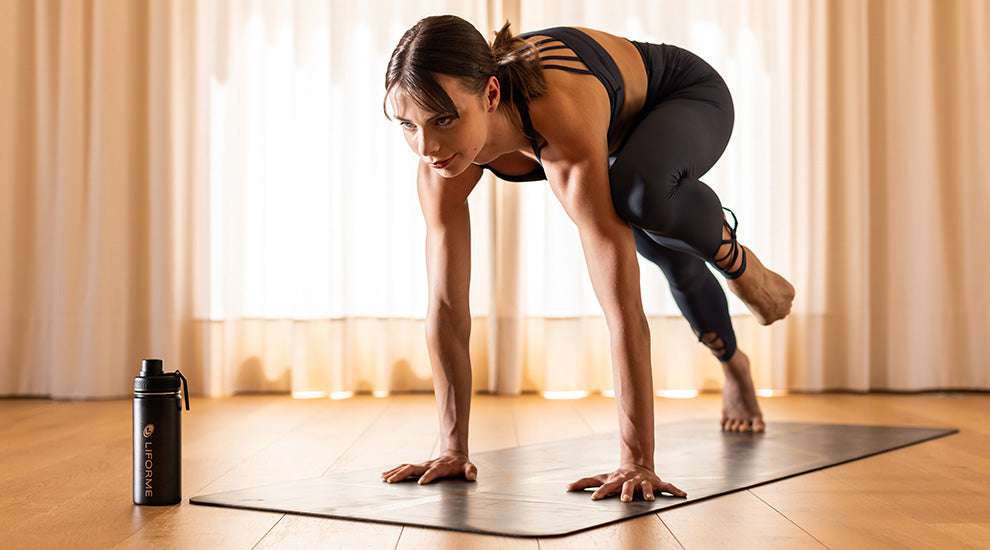
The Role of Breathing in Toning Your Body
Breathing plays a crucial role in yoga and can greatly enhance the toning effects of your practice. By incorporating specific breathing techniques into your yoga routine, you can further engage your muscles, increase oxygen flow, and promote greater mind-body connection. Let’s explore some breathing techniques that can contribute to toning your body.
Conscious Breathing
Conscious breathing, also known as deep breathing or diaphragmatic breathing, involves breathing deeply into your abdomen rather than shallowly into your chest. This type of breathing engages your diaphragm and encourages full expansion of your lungs. By consciously taking slow and deep breaths, you increase oxygen intake and promote relaxation, allowing your body to reap the full benefits of each yoga pose. Conscious breathing helps you stay present, calm, and centered during your practice, enhancing your ability to engage your muscles effectively.
Kapalabhati Breath
Kapalabhati breath, also known as skull-shining breath, is an energizing breathing technique that helps increase circulation and lung capacity. To practice this breath, sit in a comfortable position with your spine tall and your shoulders relaxed. Begin by taking a deep inhale and then forcefully exhale through your nose, actively contracting your abdominal muscles to expel the breath. Allow the inhale to happen naturally, as the forceful exhales will naturally pull in fresh air. Repeat this cycle of forceful exhales and passive inhales for several rounds. Kapalabhati breath invigorates the body, clears the mind, and aids in detoxification.
Ujjayi Breath
Ujjayi breath, also known as victorious breath or ocean breath, is a deep, audible breath that helps create heat in the body and increase focus. To practice ujjayi breath, begin by inhaling deeply through your nose, allowing your chest and belly to expand fully. As you exhale, slightly constrict the back of your throat, creating a gentle hissing or ocean-like sound as the breath passes through. Feel the breath moving in and out of your nose, enhancing your mind-body connection. Ujjayi breath not only promotes mindfulness but also helps regulate body temperature and energizes your yoga practice, contributing to greater toning effects.
Breath of Fire
Breath of Fire, also known as Kapalabhati Pranayama, is a rapid and rhythmic breathing technique that generates heat in the body and stimulates the abdominal muscles. To practice this breath, sit in a comfortable position with your spine straight and your hands resting on your abdomen. Take a deep inhale and then forcefully exhale through your nose while rapidly pumping your belly in and out. Allow the inhale to happen passively as the exhalations propel themselves. Begin with short rounds and gradually increase the duration as you become more comfortable. The breath of fire enhances circulation, energizes the body, and helps build strength and tone in the abdominal area.
Frequency and Duration of Yoga Practice for Toning
To experience the toning benefits of yoga, consistency, duration, and intensity of your practice are all key factors to consider. Let’s discuss each of these aspects in detail.
Consistency
Consistency is vital when it comes to toning your body through yoga practice. Aim to practice yoga at least three to five times per week to allow your muscles to adapt and improve over time. Consistency helps build strength, flexibility, and muscle tone more effectively than sporadic or infrequent practice. Set aside dedicated time in your schedule and make yoga a part of your regular routine to reap the full benefits of toning.
Duration
The duration of your yoga practice sessions will depend on your fitness level and schedule. Ideally, aim for sessions lasting between 30 minutes to an hour, allowing enough time to move through a sequence of poses, incorporate breathing techniques, and end with relaxation or meditation. If you’re short on time, even a 15 to 20-minute yoga session can be beneficial. Remember, consistency is key, so focus on integrating regular sessions into your routine rather than solely focusing on the duration of each individual session.
Intensity
While yoga may not be as high-intensity as other forms of exercise, you can still adjust the intensity of your yoga practice to maximize its toning effects. By holding poses for longer durations, increasing the number of repetitions, or adding resistance with props such as yoga blocks or straps, you can challenge your muscles and promote greater strength and toning. However, it’s important to listen to your body and avoid pushing yourself to the point of discomfort or pain. Gradually increase the intensity of your practice over time, allowing your muscles to adapt and grow stronger.
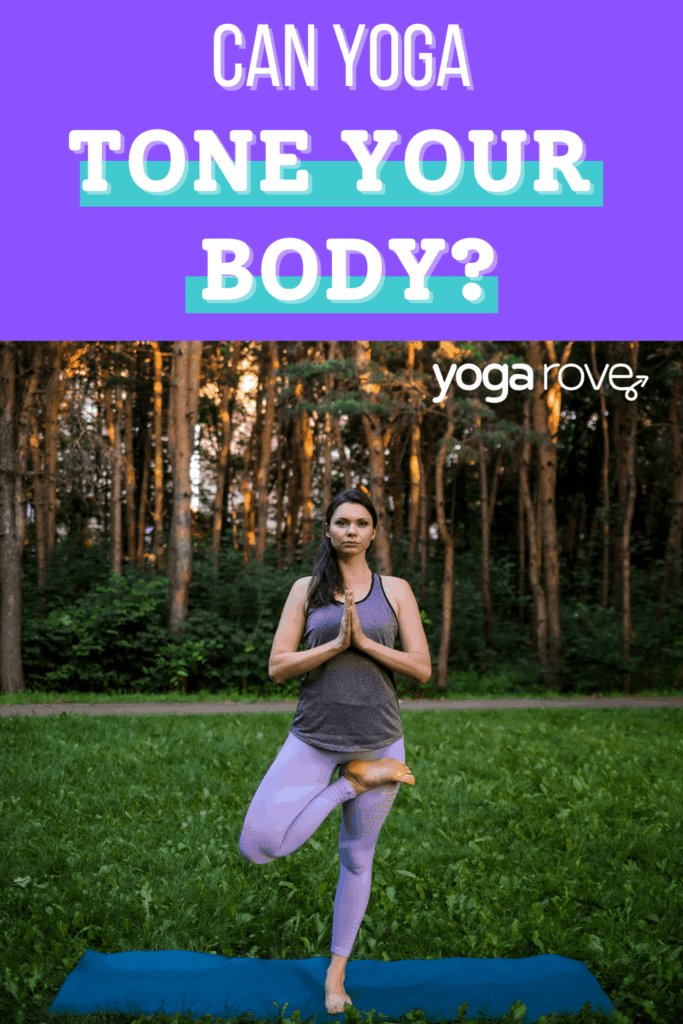
Complementing Yoga with Strength Training
While yoga offers numerous benefits for toning your body, incorporating strength training exercises can further enhance your results. Strength training, which involves resistance exercises using weights, resistance bands, or bodyweight, can help build muscle mass and increase overall strength. Let’s explore the role of strength training and how you can seamlessly combine it with your yoga practice.
Understanding Strength Training
Strength training, also known as resistance training, refers to exercises that challenge and overload your muscles, leading to muscle hypertrophy and increased strength. This form of exercise typically involves using external resistance, such as dumbbells or resistance machines, to create tension and stimulate muscle growth. Strength training exercises can target specific muscle groups or work multiple muscle groups simultaneously, depending on the chosen exercises and training program.
Combining Yoga and Strength Training
When combining yoga with strength training, it’s important to strike a balance between the two practices to avoid overtraining or creating muscle imbalances. To complement your yoga practice, consider incorporating strength training exercises two to three times a week, allowing for rest days in between to promote muscle recovery. Focus on compound exercises that engage multiple muscle groups, such as squats, deadlifts, lunges, push-ups, and pull-ups. Alternatively, you can incorporate yoga-inspired bodyweight exercises, such as Chaturanga push-ups or yoga squats, into your strength training routine. By combining these two practices, you can enjoy the flexibility, mindfulness, and toning benefits of yoga while also increasing muscle strength and definition through strength training.
Diet and Nutrition for Effective Body Toning
To achieve effective body toning, it’s essential to support your yoga practice with a well-balanced diet and proper nutrition. Proper nutrition can provide the necessary fuel for your workouts, aid in muscle recovery, and promote overall health. Let’s dive into some key aspects of diet and nutrition that contribute to effective body toning.
Caloric Intake
To achieve body toning, it’s important to maintain a calorie balance that aligns with your goals. If your goal is to lose body fat while toning, you should aim for a slightly lower calorie intake than your daily energy expenditure. On the other hand, if your goal is to build muscle while toning, you might need to consume a slightly higher calorie intake to support muscle growth. It’s important to consult with a registered dietitian or nutritionist to determine the appropriate caloric intake based on your individual needs and goals.
Macronutrient Balance
Achieving an optimal macronutrient balance is crucial for toning your body effectively. Focus on consuming an adequate amount of complex carbohydrates, lean protein sources, and healthy fats. Carbohydrates provide energy for your workouts, protein helps repair and rebuild muscle tissue, and healthy fats support overall health and hormone regulation. Opt for whole-grain foods, lean meats or plant-based protein sources, and incorporate healthy fats from sources such as nuts, avocados, and olive oil into your diet. It’s important to strike a balance that suits your specific needs, goals, and any dietary restrictions or considerations you may have.
Hydration
Proper hydration is often overlooked but plays a significant role in effective body toning. Drinking an adequate amount of water throughout the day helps maintain optimal bodily functions, supports muscle performance, and aids in recovery. Aim to consume at least eight to ten cups (64-80 ounces) of water per day, or more if you engage in intense or prolonged workouts. It’s especially crucial to hydrate before, during, and after your yoga practice to replenish fluids lost through sweating and support muscle function.
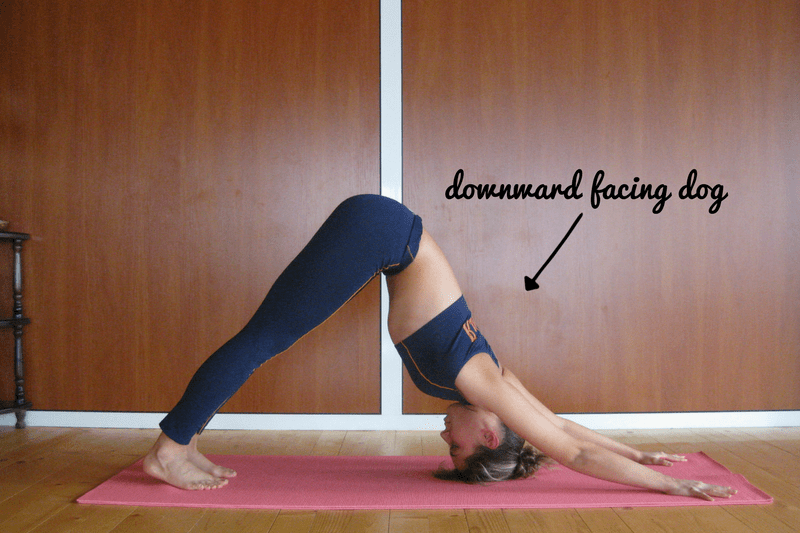
Avoiding Common Mistakes in Yoga Practice for Toning
While yoga can be a highly effective practice for toning your body, it’s essential to avoid common mistakes that can hinder your progress or cause injury. Here are a few mistakes to avoid when practicing yoga for toning purposes.
Improper Alignment
Maintaining proper alignment in yoga poses is crucial to ensure safe and effective toning. Poor alignment can place undue stress on your joints, limit the effectiveness of the pose, and increase the risk of injury. Always pay attention to your instructor’s cues or use proper alignment guides to ensure you are performing poses correctly. If you’re practicing at home, consider using a mirror or recording yourself to check your form. Proper alignment ensures that you are engaging the appropriate muscles and maximizing the toning benefits of each pose.
Overexertion
While it’s important to challenge yourself in yoga to promote muscle growth and toning, overexertion can hinder your progress and increase the risk of injury. Pushing your body beyond its limits or forcing yourself into poses that are beyond your current capability can do more harm than good. Listen to your body and respect its limits. Take breaks when needed, modify poses if necessary, and gradually progress at your own pace. Consistency and gradual progression are more effective for toning than sporadic high-intensity practices.
Skipping Rest Days
Rest days are essential for muscle recovery and growth. While it can be tempting to push yourself with daily intense yoga sessions when aiming for toning, it’s important to incorporate rest days into your routine. Muscles need time to repair and rebuild after workouts, and rest days allow for optimal recovery. Aim for at least one to two rest days per week, where you can engage in gentle activities, stretch, or focus on mindfulness practices such as meditation or deep breathing. Embracing rest and recovery is just as important as the physical practices for achieving optimal toning results.
Recognizing Progress and Setting Realistic Goals
When embarking on a yoga journey for toning your body, it’s crucial to recognize and celebrate your progress along the way. Setting realistic goals and monitoring your body changes can help you stay motivated and maintain a positive mindset. Here’s how you can track your progress and establish realistic goals.
Monitoring Body Changes
As you engage in a consistent yoga practice, pay attention to any positive changes in your body. Notice how your muscles feel more toned and defined, how your clothes fit differently, and how your balance and flexibility improve over time. Take progress photos periodically to visually track your transformation. Remember that toning your body is a gradual process, and results may take time to become evident. Celebrate the small victories along the way and trust in the process.
Setting Short-Term and Long-Term Goals
Setting both short-term and long-term goals can help maintain your focus and ensure continued progress. Short-term goals can be achieved within a few weeks or months and can be as simple as holding a specific yoga pose for a certain amount of time or increasing the number of repetitions in a strength training exercise. Long-term goals may take several months or even a year to accomplish and can include achieving a certain level of flexibility, toning a specific muscle group, or mastering more advanced yoga poses. Be sure to set goals that are realistic, measurable, and specific to your individual capabilities and circumstances. Celebrate each milestone and use them as stepping stones towards your ultimate toning goals.
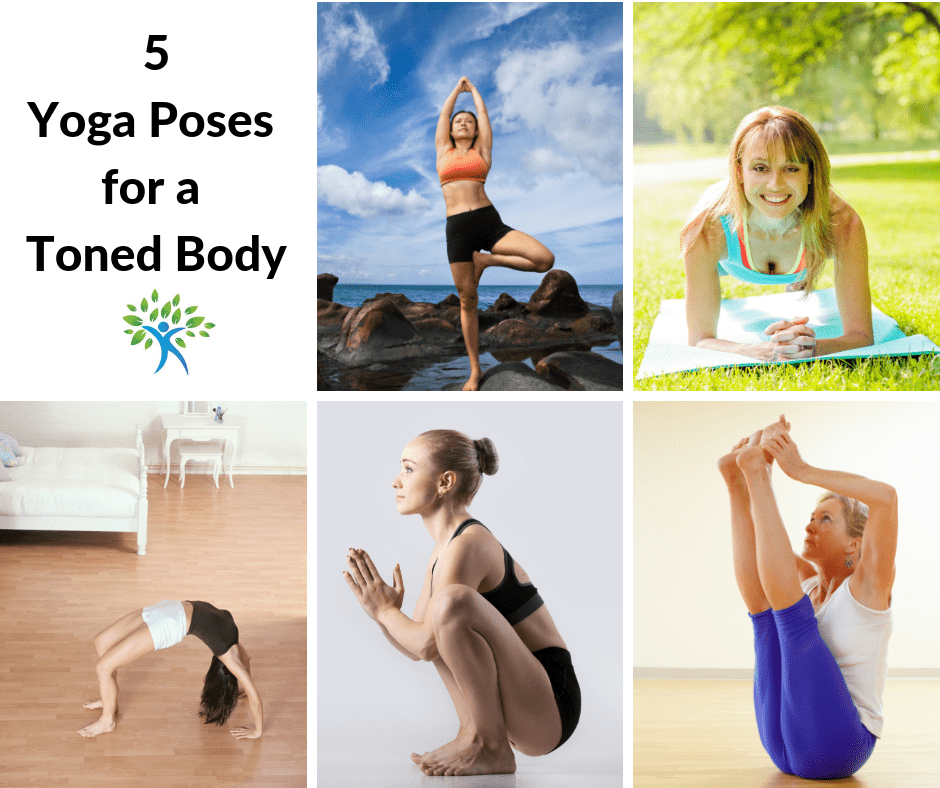
Adapting Yoga for Different Fitness Levels
Yoga is a highly adaptable practice that can cater to different fitness levels, from beginners to advanced practitioners. Whether you’re just starting your fitness journey or have been practicing yoga for years, there are modifications, challenges, and variations available to suit your specific needs and goals.
Beginner Modifications
If you’re new to yoga or have limited experience with physical exercise, it’s important to start with beginner modifications to build a strong foundation and prevent injury. Beginners can begin with gentler forms of yoga, such as Hatha or Vinyasa flow, which focus on basic poses and slow movements. Modify poses as needed by using props such as blocks, straps, or blankets to provide support and help with proper alignment. As you gain strength and confidence, gradually progress to more challenging poses and sequences.
Intermediate Challenges
For those who have been practicing yoga for some time and have developed a solid foundation, incorporating intermediate challenges can help take your toning to the next level. Intermediate challenges can involve holding poses for longer durations, experimenting with advanced variations of poses, or adding strength training elements to your yoga practice. Consider trying more dynamic styles such as Power or Ashtanga yoga, which incorporate more strength and cardiovascular elements into the practice. Always listen to your body and avoid pushing yourself beyond your limits.
Advanced Variations
Advanced practitioners can explore more challenging poses, sequences, and variations to continue toning and progressing in their yoga practice. Advanced variations often involve complex inversions, arm balances, and deep backbends. These poses require significant strength, flexibility, and body awareness, so it’s important to approach them with caution and under the guidance of an experienced teacher. Always warm up properly, practice in a safe environment, and gradually progress into advanced variations over time.
Consulting with a Yoga Instructor or Personal Trainer
If you’re unsure about how to structure your yoga practice for toning your body or need guidance on proper form, seeking professional guidance from a yoga instructor or personal trainer can be highly beneficial. These professionals can provide expert knowledge and customized advice tailored to your specific needs and goals.
Seeking Professional Guidance
A certified yoga instructor can assess your fitness level and goals and help design a yoga routine that targets the muscle groups you wish to tone. They can teach you proper alignment, offer modifications for poses, and guide you through a well-rounded practice catered to your abilities.
Customizing a Yoga Routine
A personal trainer with experience in both yoga and strength training can customize a yoga routine that complements your other fitness activities and specific goals. They can help you integrate yoga and strength training exercises effectively, ensuring proper form and progression. By combining the expertise of a personal trainer with your yoga practice, you can maximize the toning benefits and accelerate your progress towards your desired physique.
In conclusion, regular yoga practice can indeed help in toning your body. The benefits of yoga for muscle strength, flexibility, definition, weight loss, posture, and balanced body composition make it a valuable addition to your fitness routine. By incorporating specific yoga poses, utilizing proper breathing techniques, maintaining consistency, balancing duration and intensity, complementing with strength training, prioritizing a balanced diet, avoiding common mistakes, setting realistic goals, adapting for different fitness levels, and seeking professional guidance, you can optimize the toning effects of your yoga practice and achieve a more toned and sculpted physique. Embrace the journey, stay consistent, and enjoy the holistic benefits of practicing yoga for body toning.
